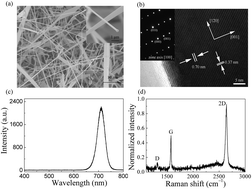Novel graphene–oxide–semiconductor nanowire phototransistors
Abstract
Novel graphene–oxide–semiconductor (GOS) nanowire phototransistors have been fabricated for the first time. Monolayer graphene, high-κ HfO2, and CdSe nanowire (NW) were used as transparent top-gate, gate dielectric, and conductive channel, respectively. Electric measurements of the devices reveal a clear field effect. In the dark, the on/off ratio, threshold voltage, subthreshold swing, and peak transconductance are about 4.9 × 106, −1.5 V, 120 mV dec−1, and 2.3 μS, respectively. The photo-response characterization demonstrates that the gate voltage has a remarkable modulation effect on the responsivity of the phototransistors. Under 633 nm light illumination, the responsivity, gain, and specific detectivity can be as high as 1.06 × 107 A W−1, 1.93 × 107, and 9.68 × 1015 Jones, respectively. To the best of our knowledge, these values are among the highest reported so far for NW-based photodetectors. Our results demonstrate that GOS NW phototransistors promise a potential application in weak light detecting, which is highly desired in future optical communication or nanoscale integrated optical circuits.


 Please wait while we load your content...
Please wait while we load your content...